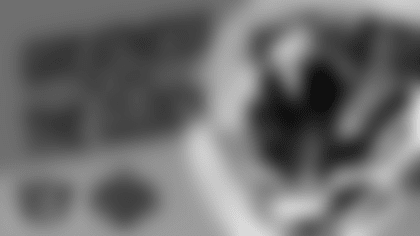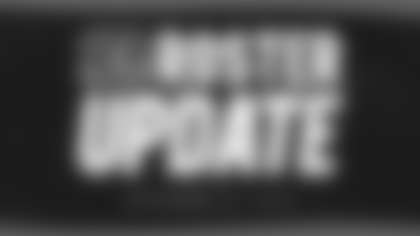With ten picks queued up for the April 25-27 draft, the Bengals are in a position to move around the board on the clock as director of player personnel Duke Tobin sifts through his second decade of guiding the Paycor Stadium draft room.
Bolting up or sliding down in a draft-day trade presents a dizzying set of mechanics. Remember how they grabbed one of their budding Pro Bowlers in Nebraska cornerback Cam Taylor-Britt during the 2022 second round when they moved up three spots?
"There are a lot of tense moments in the draft when names you like are falling off the board," says director of college scouting Mike Potts. "You don't mind giving up compensation if you can fit a need and you think he's a starting caliber player at a valuable position. It has to be a fit for both sides. There are always a lot of conversations and that means there are a lot that fell through. But you have to be prepared."
Go back to April 29, 2022, and the Bengals were still riding high from the night before. They were able to pick Michigan safety Dax Hill at No. 31 even though he was one of only a dozen or so players with a first-round grade.
But alarm bells went off right away with the first pick of the next night in the second round. Edge Logan Hall, a player they thought they might be able to get at some point in the round, went at No. 33. Then in quick succession so were a trio of cornerbacks, a position of need: Roger McCreary, Kyler Gordon, and Andrew Booth. Gone by No. 42. So was the intriguing Baylor safety Jalen Pitre.
And their pick at No. 63 loomed like a long, lonesome Texas highway.
"You usually target a group of players. If that group gets thinned out and there's one or two that are left that you feel good about and you don't want to drop down a level, then you're looking to move up," Potts says.
But this isn't the chaotic movie Draft Day. This is draft day, another day at the office and that's the mood in the not-so-war room. Think more like the consoles in For All Mankind with engineers wordlessly hunched over humming data as the scenarios they've discussed for months unfold.
"You've got to remember," says Bengals area scout Christian Sarkisian, "we've been talking about these guys since Halloween."
Sarkisian is getting ready for such a moment right now with the draft three weeks away, another reason the pulse stays the same even as the names furiously shuffle with seven minutes between picks in the second round. And just five minutes the rest of the way, except for four in the seventh round.
Now is about this time he and football data analyst Sam Francis start conferring in the weeks leading up to the draft before Francis stays in his office while Sarkisian goes into the draft room armed with the Bengals version of their trade value chart.
The most famous NFL Draft trade chart belongs to Jimmy Johnson after he used it to turn around the Cowboys in the early '90s. However some view the map as outdated because it doesn't give enough weight to the middle and late rounds. The one most cited now seems to be Pro Football Focus' Fitzgerald-Spielberger map.
One thing is for sure. Teams guard their charts like nuclear codes. But, truth be told, with analytic engineers putting values on items that change every year, such as team needs and the strength of each draft, every team now probably has what amounts to their own annual trade charts.
Plus, a lot of it is just downright intuition on the clock.
And April preparation.
"I enjoy dealing with the trade chart because the work that goes into the weekend really familiarizes you with the teams," Sarkisian says. "You have to know the draft capital of each as well as their needs the way their current roster is. You have to able to answer questions while the draft is going on, but just as a fan of the league it gives you a holistic view."
In the last decade, Tobin has raised a staff suddenly seasoned while coming of age and building a Super Bowl contender. It's also one that has become familiar with working a draft-day trade for a team that once preferred to stay put.
Since his longest-tenured lieutenant, director of pro scouting Steven Radicevic, arrived for the 2013 draft, the Bengals have pulled off 11 trades on the clock, more than any previous stretch in club history. A total of seven have come during head coach Zac Taylor's five drafts, and there have been four in the four drafts of the 2020s.
During that stretch, the Dukedom has also been streamlined. No more position coaches and other staff. Joining Tobin's scouts and the ownership group led by Bengals president Mike Brown are Taylor and his three coordinators.
But even though cornerbacks coach Charles Burks was in his office watching his first draft with the team, he had been heavily involved in the pre-draft work at his position. He can still tell you how he wrote up Taylor-Britt.

2024 NFL Draft
The Bengals source of news, interviews, photos and more at the 2024 NFL Draft.
"Cam can play all three positions in the secondary because he has that type of skill set," says Burks, taken right away when he first saw CTB at the scouting combine attacking the ball. "He's a guy that can get people lined up and play safety. He's a guy that can go in and play nickel. He's a guy that can match up against the best receiver. When he came on a pre-draft visit, you really got to see who he was as a person and his energy. That's what made you fall in love with Cam. When you got to meet him as a person."
Burks' report matched the one filed by the area scout, which just happened to be Sarkisian in his role patrolling schools largely in the Central time zone. Along with trips to Lincoln, Sarkisian also emerged with an observation from a then Bengal Stanley Morgan Jr., his teammate at Nebraska.
"The thing that got me most excited is when Stanley talked about the leadership, the competitor, the worker that Cam is," Sarkisian says. "All the stuff I saw and heard at Nebraska checked out. The leadership that they talked about. You look at his impact and the daily energy he brought there. They called him 'The Energizer Bunny.'"
Plus, they needed another starting-level cornerback. But there were other prospects in their pool, too, between No. 42 and No. 63. Just not for long. The Ravens grabbed edge David Ojabo at No. 45. Alontae Taylor, another cornerback they visited with plenty, went to the Saints at No. 49 as Burks watched waiting to fill a chair in his office.
"I also had struck up a good relationship with Alontae Taylor," Burks says. "As a coach in the National Football League, the way I see it is whatever player we draft, when he comes into this room I'm going to make it work."
The memories are hazy, but the phone calls most likely started after wide receivers George Pickens went to Pittsburgh at 52 and Alec Pierce to the Colts at No. 53. The universe of players Potts talks about had whittled to a precious few.
"Every situation is different," Potts says. "Maybe 15 picks out you've got five to seven guys you like. Then maybe the group gets thinned out five picks away and now there's a little more urgency to make a move if you feel like you want to give up another pick or two so you don't drop down another level of player."
Tobin and Potts sit next to each other and as the names are crossed off, they split up the teams to call, all the while monitoring their texts and maybe checking on what assets teams have.
It can vary, but usually Tobin is talking to the general managers while Potts is talking to other executives. Both are looking to set up the groundwork. That's where Sarkisian's chart comes in. It's more of a tool to set a trade's parameters so both sides aren't starting out in left field.
"Hey, if you're still interested when you're on the clock," a conversation may start with a player you like hanging out there. Another pick or two may go by and a deal Potts has sketched out with a club is now being talked about by Tobin and his counterpart.
"And you can't finalize anything until you or the other team is on the clock," Potts says. "Obviously, a guy has to be there."
Taylor-Britt had been the top player on their board for a while, so Tobin finished up the deal with the Bills at pick No. 60. In exchange for moving up from No. 63, the Bengals gave up a sixth-rounder. No. 209.
But it wasn't so much about the Bills at No. 60. It was about who they were in front of and who the Bengals were behind. You've got to know who to jump ahead of and after Bengals quarterback Joe Burrow had just riddled the Chiefs secondary twice in a month, they figured at No. 62 Kansas City was looking for a defensive back after taking edge George Karlaftis in the first round.
As they shook hands and Taylor got Taylor-Britt on the phone, they looked at their computers as the Chiefs took University of Cincinnati safety Bryan Cook.
"Cam's a great pick, a great player," Burks says. "You just never know how the draft goes."
According to the Jimmy Johnson chart, the Bengals won the trade with plus 17. They had a minus score on Fitzgerald-Spielberger, but the way that chart is set up, it was pretty much a wash. But not in Bengaldom, where Taylor-Britt's play has been pretty much off the charts.
Burrow-esque work against the clock.
"A lot of different scenarios," Potts says. "A lot of conversations. But you have to do them all."








